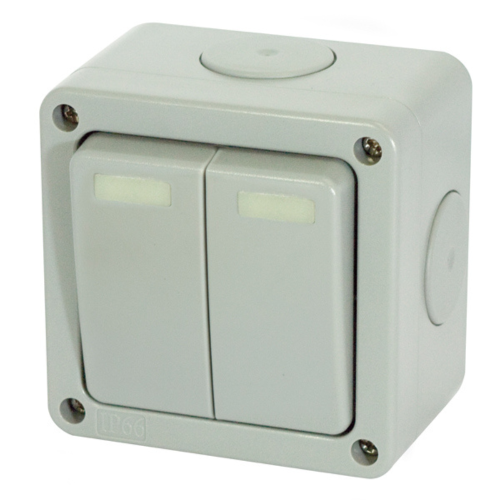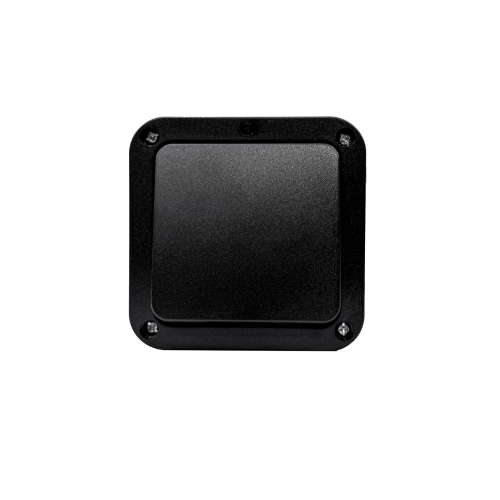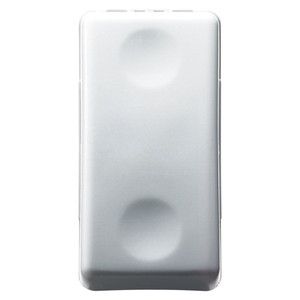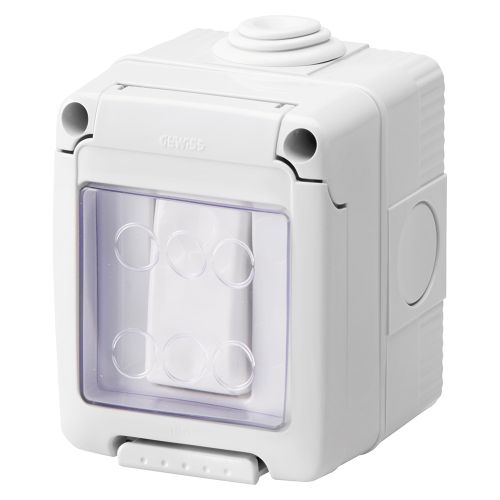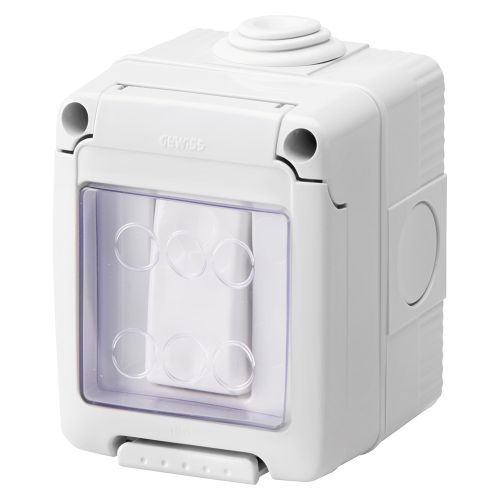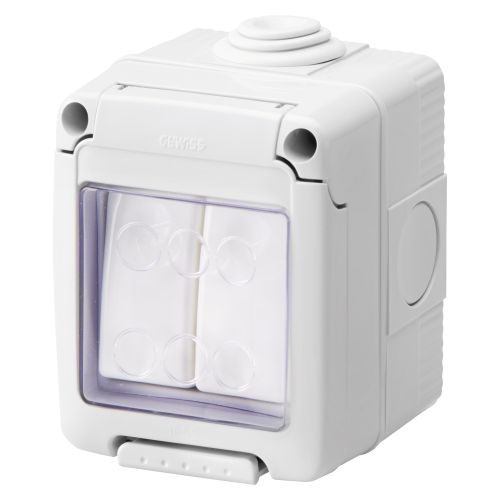Switches
Our range of IP-rated weatherproof switches has been designed to give you the ability to run power to switch exterior lighting safely from outside areas. These types of weatherproof or waterproof light and outdoor switches are constructed from tough robust polycarbonate housing that is durable and safe to use outside. We stock a broad range of leading brands including Gewiss and Live.
What are IP outdoor switches?
IP Rated switches to protect against dust and water ingress, our range includes IP66 and IP55 types. The recommended IP rating for outdoor sockets and switches ranges from IP54 up to IP66. So, our selection is perfect for outdoor use. 1 gang, 2 gang, and grid options are available. IP is short for ingress protection, it is the standard used to rate the ability of sealants to protect against moisture and dirt.
Browse our range of exterior switches and weatherproof and waterproof electrical sockets. Order today for next-day delivery.
Weatherproof Sockets
Outdoor sockets are important for lighting, heating, and other electrical sources. More and more people are installing weatherproof sockets to provide energy to outdoor lighting features. These specialised weatherproof sockets have features that allow them to withstand any hard outdoor elements.
It is important to install weatherproof sockets safely and securely to ensure they last a long time and don’t damage the electrical appliances. Here are some important factors to consider before installing outdoor sockets.
What Are Weatherproof Sockets?
A weatherproof or outdoor socket is a receptive electrical connector commonly used for electrical current. This weatherproof socket is specially modified from a regular socket to fit outdoor electrical needs.
A receptive electrical connector is a mechanism into which another card is plugged in. In a regular electrical receptive connector, anyone exposing a charged electrical socket to water increases the danger risks. Non weatherproof sockets can cause an electrical short circuit, which can hurt you and damage your electrical appliances.
With a weatherproof socket, you can greatly reduce the risk of equipment damage and physical injury. An outdoor electrical socket comes in two different forms, covered and non-covered outdoor electrical socket.
Regardless of the cover configuration, all outdoor electrical sockets have a protective casing which creates a weatherproof housing unit, and these protected outdoor electrical sockets provide an area for power supply in an outside space. Most outdoor electrical sockets can be installed on an exterior wall.
Installing weatherproof electrical sockets in the outside space allows electrical garden lighting and equipment to be used safely without the need for long trailing cables throughout the house. Such long-running cables are not only a tripping hazard, but they can also cause damage to your equipment; therefore, you must use weatherproof electrical sockets.
Outside sockets have an IP66 rating which means that these outside sockets provide protection against water, dust, and other environmental elements to provide a reliable power source in the outdoor area. Outside sockets come in a variety of sizes with various features to suit any type of installation.
At Meteor Electrical, you can find a range of outside sockets, including smart weatherproof electrical sockets for added control and comfort. Visit Meteor Electrical to find the best weatherproof electrical sockets for your home.
What Is The Structure Of Weatherproof Sockets?
The simplest outdoor electrical sockets are manufactured by taking regular indoor electrical outlets and, in some instances, adding a hinged cover to protect the outdoor electrical sockets from environmental elements.
Some outdoor electrical sockets have covers made out of hard plastic material, but other outdoor electrical sockets have a painted wood cover or a flexible rubber covering. Each of these covering has a different quality that benefits your outdoor electrical sockets.
Outdoor electrical sockets with these types of coverings are commonly referred to as outlet boxes. More advanced or complex weatherproof sockets frequently include a reset circuit called a Ground Fault Interrupter or GFI. The GFI is an important component as it prevents electric shocks when water interacts with the outdoor sockets.
The GFI detects the abnormal difference in the currents between the two wires in the outdoor sockets. The presence of the current difference means that the electricity supply is being diverted to somewhere else. If the GFI detects an abnormal power level, it automatically disconnects the outdoor sockets from power. This process protects your outdoor sockets from getting damaged.
The GFI outdoor sockets can be mounted directly at the outlet section, or you can install the GFI mechanism in a breakers box elsewhere in your household or commercial building. However, it is important to note that the breaker installation is less convenient for outdoor sockets that need to be reset frequently, but the breaker location does hold several potential safety benefits.
Outdoor sockets with a GFI mechanism have a test button. With this button, you can send an even current to the GFI outlet, which will immediately shut down your outside sockets. This button is found in both non-breaker and breaker GFI outlets.
In most cases, manufacturers create outside sockets with a GFI mechanism and a water-resistant cover. These types of weatherproof electrical sockets provide added protection for your outside outlets. Some local building codes require weatherproof electrical sockets installation near swimming pools and outdoors.
Apart from household use, weatherproof sockets are commonly used on the exterior of motor homes and on boats. Some weatherproof sockets are also used in a commercial building’s outdoor spaces.
Weatherproof electrical sockets on boats and other vehicles are powered with a generator or battery packs instead of the grid. However, the voltage and amplitude of the power are the same as the power levels in a household.
In addition to a regular power outlet, weatherproof electrical sockets can also be used for several types of outdoor power sources or data connections. For instance, you can mound a universal serial bus (USB) into waterproof outdoor power sockets to use with a motorcycle.
It is important to note that low-power weatherproof sockets do not have a GFI mechanism. For data connection, you can mount your data equipment to weatherproof sockets; however, if you want to use a high bandwidth application, you should use a wireless solution.
How Safe Are Weatherproof Sockets?
Safety is one of the most important deciding factors for installing weatherproof sockets. Since your outside sockets are exposed to outdoor environmental elements, it is important to ensure the safety of these outlets as they will affect your power supply. A damaged outlet can also ruin your electrical appliances. However, these concerns are diminished with high-quality weatherproof sockets.
Weatherproof sockets for outside use are specially designed to keep rainwater out of the electrical outlet. This quality makes weatherproof sockets extremely safe for use when installed in the correct manner. There is a wide variety of weatherproof sockets, and each has a different safety mechanism that provides security to your electrical outlets.
Some weatherproof sockets come equipped with a mechanism called the residual current device. The residual current feature will automatically cut off the electrical power supply when a fault is detected.
When purchasing outdoor power sockets, make sure to look for an outdoor socket with the RCD feature. Suppose your outdoor or external sockets do not include an RCD feature. In that case, you must install the mechanism separately elsewhere in your wiring system to protect your weatherproof socket from accidents and hazardous conditions.
Weatherproof sockets also include a covering that forms a seal around the outlet. This seal protects the outside sockets from water and dust. Both water and dust negatively affect the functionality and safety of your weatherproof sockets. The seal makes the weatherproof sockets a highly safe choice for outdoor electrical sources.
Depending on the type of weatherproof socket, the appropriate kind of power source will vary. For instance, if you are looking to install a water feature in your garden that uses more than 32A of energy source, you might need to directly hard-wire the water feature to your building’s electrical circuit system. However, if the electrical appliance uses a lower amp range such as 13A, then an outside socket will work best if it is installed approximately 2 metres away from the water feature.
For any device that needs a simplified weatherproof outlet solution, you must find a specifically-designed socket to make sure that the outlet is completely weatherproof. Always avoid using a non-weatherproof socket outside your home; these sockets include the ones you might find in your household.
Electricians strongly advise against using such outlets because they do not fit the outdoor environment well. In-home outdoor sockets are not fit to handle outdoor elements, and these outlets do not have a waterproof cover that will provide protection.
Non-weatherproof sockets have the potential to damage electrical devices and create hazardous situations. For the safest choice, always choose sockets that are designed for outdoor use. Always look for outdoor sockets with a minimum IP rating of IP56 to ensure that your weatherproof sockets are weather resistant.
What Is IP Rating In Weatherproof Sockets?
An IP rating is essential as it determines the quality of a weatherproof socket. If a weatherproof socket does not have an adequate IP rating, it will not provide sufficient protection for your electrical appliances. Here are some important things to know about IP ratings.
An IP rating is primarily a two-digit grading system that is given to an electrical item or the enclosure of a mechanical item. An IP rating is short for the Ingress Protection mark. IP is also called the Internal or International Protection mark in some markets.
The rating offers consumers a clear indication of the item’s reliability and resistance to various hazardous intrusions. In the context of IP ratings, there are several different types of intrusions. For weatherproof sockets, such instructions protect users (their hands, fingers, etc.) against environmental elements (like dirt, dust, water) and other damaging factors.
The IP rating for outdoor electrical sockets also measures moisture resistance. There are slight differences in IP ratings depending on the location; however, most IP ratings are standardised.
In the UK, IP ratings are assigned in accordance with the British regulation of BS EN 60529:1992. The main reason for a universal IP rating system is to ensure that consumers and buyers are confident of their electrical or mechanical goods’ safety in specific applications and environments.
Some companies use vague marketing terms such as “waterproof” without any clear indication that provides proof of this ability. An IP rating is designed to provide specific proof regarding the safe functionality of your electric device.
Since safety is an important factor in the overall health of outdoor electrical sockets, it is important that you look for this rating before making a purchase. Visit Meteor Electrical to find a wide range of IP-rated weatherproof sockets that ensure the safety of your electrical enclosure.
Weatherproof Sockets IP Rating
A weatherproof or waterproof IP rating is a specific rating given to weatherproof sockets to ensure that they work properly in outdoor conditions and keep your electrical components protected from outdoor hazards.
Apart from weatherproof sockets, this IP rating is found in mobile phones, light fixtures, CCTV enclosures, and more. When it comes to labeling outdoor electrical sockets, it is important to look beyond the “weatherproof” label. You must look for a specific IP rating digit to determine if the weatherproof socket offers protection or not. This is because an IP rating clearly defines the protective parameters and evaluates the effectiveness of your weatherproof sockets.
The commonly accepted rating for weatherproof sockets is IP65, IP66, and IP67. These ratings indicate protective outside sockets for general use. One of the most common misconceptions regarding weatherproof IP ratings is the value of IP ratings. It is assumed that the higher the rating, the better the moisture and dust resistance. However, this is not accurate as the value is determined by a number of other factors.
Can Weatherproof Sockets Be Used Indoors?
Since weatherproof sockets are numerous protective qualities, it is tempting to use such sockets indoors, especially in the bathroom. However, you must reserve the use of outdoor electrical sockets for indoor use unless stated otherwise in the product description.
Regular electrical outlets should always remain a minimum of 3 metres away from a shower or bath, but it’s always recommended to keep outlets out of the bath section, if possible. There are special sockets manufactured to be installed closer to water sources. These include specific shaver units commonly found in bathrooms. It is not recommended to install outdoor sockets as a replacement for such outlets.
What Are The Benefits Of Weatherproof Sockets?
Here are some important benefits of installing weatherproof sockets in your outdoor living space.
Cut Down Use Of Extension Cables
One of the biggest benefits of specialised outdoor sockets is that you cut down the use of extension cables. It is extremely inconvenient and risky to run extension cords from an indoor socket to get electrical power in your outdoor living space.
Cables running over the walking area or grass are a potential tripping hazard, and someone might fall and sustain severe injuries if they don’t notice the extension cable. Overheating and overloading are some other common problems associated with the use of extension cables.
Using extension cables in such a manner may lead to fires and/or electrical shock. By installing outdoor electrical sockets, you cut down the need for extension cables, and in this way, you reduce the risk associated with such cords.
More Convenience In Gardening Work
There are various tools and equipment required to maintain a garden. Such tools include lawnmowers, hedge trimmers, and more.
Outdoor electrical sockets make it easier to plug in these tools to ensure they reach every corner of the garden. Outdoor sockets eliminate the need to run your wires to find an indoor electrical outlet.
Easier To Hang Lights In Garden
Outdoor electrical sockets make it easier to hang festive lighting during the holiday season. Outside outlets allow easy connection for the lights, and it also allows you to turn them on or off conveniently.
Outdoor sockets reduce the need to power multiple stands and the load on your indoor electrical sockets. This process also frees up indoor electrical units for other appliances.
Create A Hospitable Outdoor Living Space
When installed correctly, outdoor electrical sockets can significantly benefit homeowners who enjoy spending time in their outdoor living space. Outdoor electrical sockets make it easier to power laptops and mobile phones to work outside. You can also use these units to power speakers, mini-fridges, patio lighting, and an electric grill.
If you want to use such electrical items, it is important that you must install outdoor sockets. Running extension cables for such electrical items is dangerous and can lead to hazardous situations. With dedicated outdoor sockets, you don’t have to worry about overloading your electrical outlets.
What Is The Best Practice For Installing Weatherproof Electrical Sockets?
Before installing weatherproof electrical sockets, it is important to follow all the proper parameters to ensure the efficiency of the socket. An experienced or qualified electrician should carry out all installations of weatherproof sockets. This factor is important because the consequences of improper installation can be fatal.
If water gets into the outdoor socket during installation, it can create a highly dangerous situation. Due to this reason, it is necessary that whoever installs the outdoor sockets should follow proper practices to ensure their personal safety as well as the outlet users’ safety.
If possible, it is recommended to drill through the back of an existing indoor outlet when installing an outdoor electrical outlet. This installation method ensures that the two sockets are adjacent to each other. In addition, if you use a metal mounting box for the outdoor socket installation, you must earth the metal box for extra safety. However, you do not need to earth the mounting box when using a plastic mounting box.
You should be strategic when it comes to the outdoor socket’s installation location. Always keep your outdoor socket away from the pool; however, if you want to install an outdoor plug for hot tubs, you must follow specific installation directions.
Always install the outdoor socket two metres away from the hot tub and never less than one metre away from the electrical item. When choosing the best place to install an outdoor socket for general use, it is best to install the socket at the shortest distance from the indoor electrical unit. As mentioned before, always consult with or ask a qualified electrician to carry out weatherproof socket installation.
Enhance your outdoor space with the convenience and safety of weatherproof sockets from Meteor Electrical. Our top-quality outdoor plugs are designed to withstand harsh elements, ensuring reliable power for lighting, heating, and other electrical needs in your garden or patio. Installing weatherproof sockets is essential for both safety and longevity, protecting your electrical appliances from potential damage. Explore our range of outdoor plugs, including smart weatherproof electrical sockets for added control and comfort. Visit Meteor Electrical to discover the best-in-class weatherproof electrical sockets and elevate your outdoor living experience. Don't compromise on safety – choose Meteor Electrical for all your outdoor plug needs!

